Sustainable Tourism Development: Analysis and Recommendations Report
VerifiedAdded on 2020/01/28
|19
|6030
|93
Report
AI Summary
This report comprehensively examines sustainable tourism development, analyzing its various facets and providing valuable insights. It begins with an introduction that highlights the growing importance of the tourism sector globally and emphasizes the need for sustainable practices that consider environmental, social, and economic impacts. The report then delves into the benefits of tourism development planning for stakeholders such as the government, tourism enterprises, local populations, and tourists, while also assessing the advantages and disadvantages of public-private sector partnerships in tourism planning. Furthermore, it explores the features of tourism development planning at different levels (international, national, regional, and sub-regional) and discusses the significance of interactive planning in tourism development. The report also covers methods for measuring tourist impact, the concept of sustainability in tourism, factors hindering sustainable tourism, and stages of planning for sustainability. It addresses conflict resolution methods, balancing demand and supply, and ethical issues in enclave tourism. Finally, the report compares current issues in Croatia and Nepal, offering recommendations for sustainable tourism practices. The report concludes by summarizing key findings and providing references for further study.
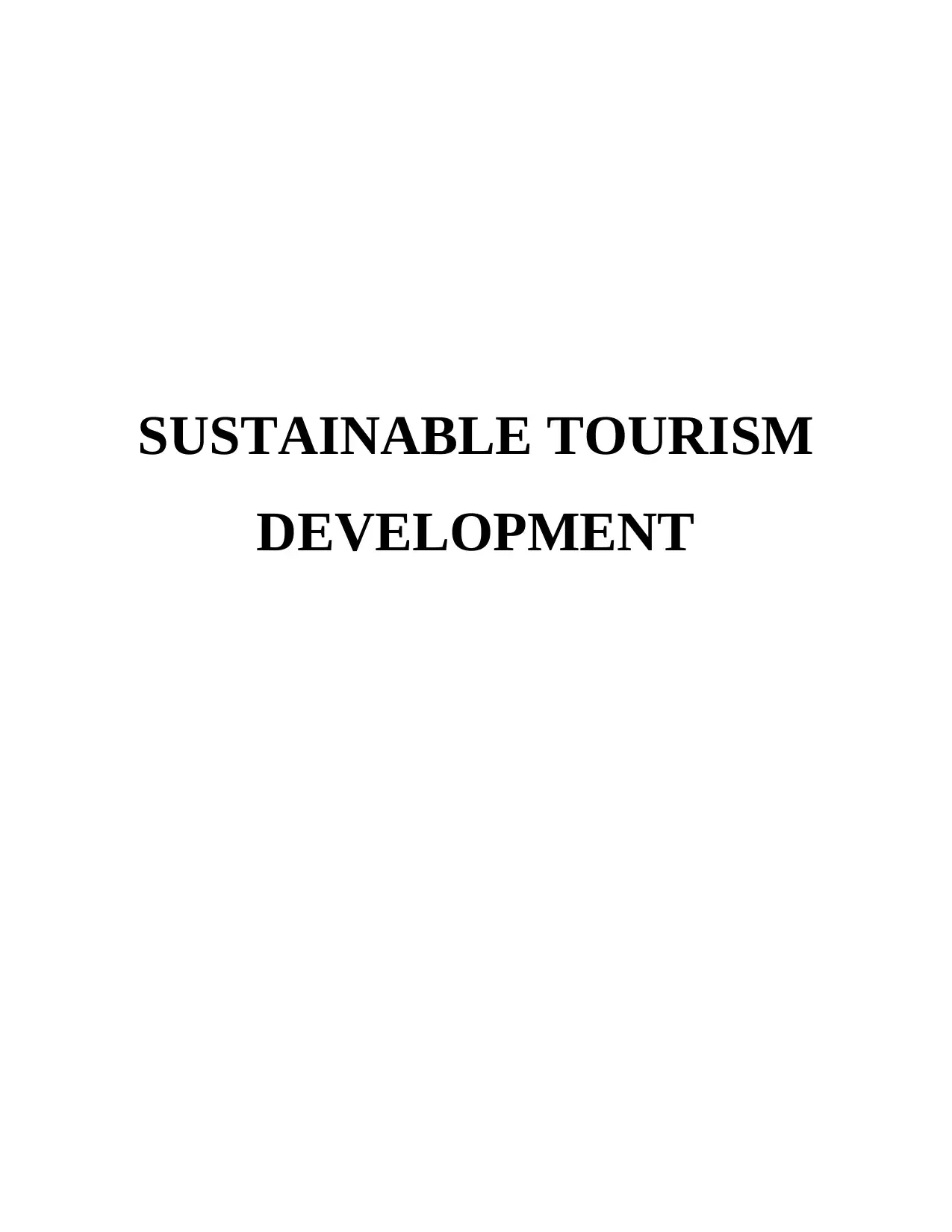
SUSTAINABLE TOURISM
DEVELOPMENT
DEVELOPMENT
Paraphrase This Document
Need a fresh take? Get an instant paraphrase of this document with our AI Paraphraser
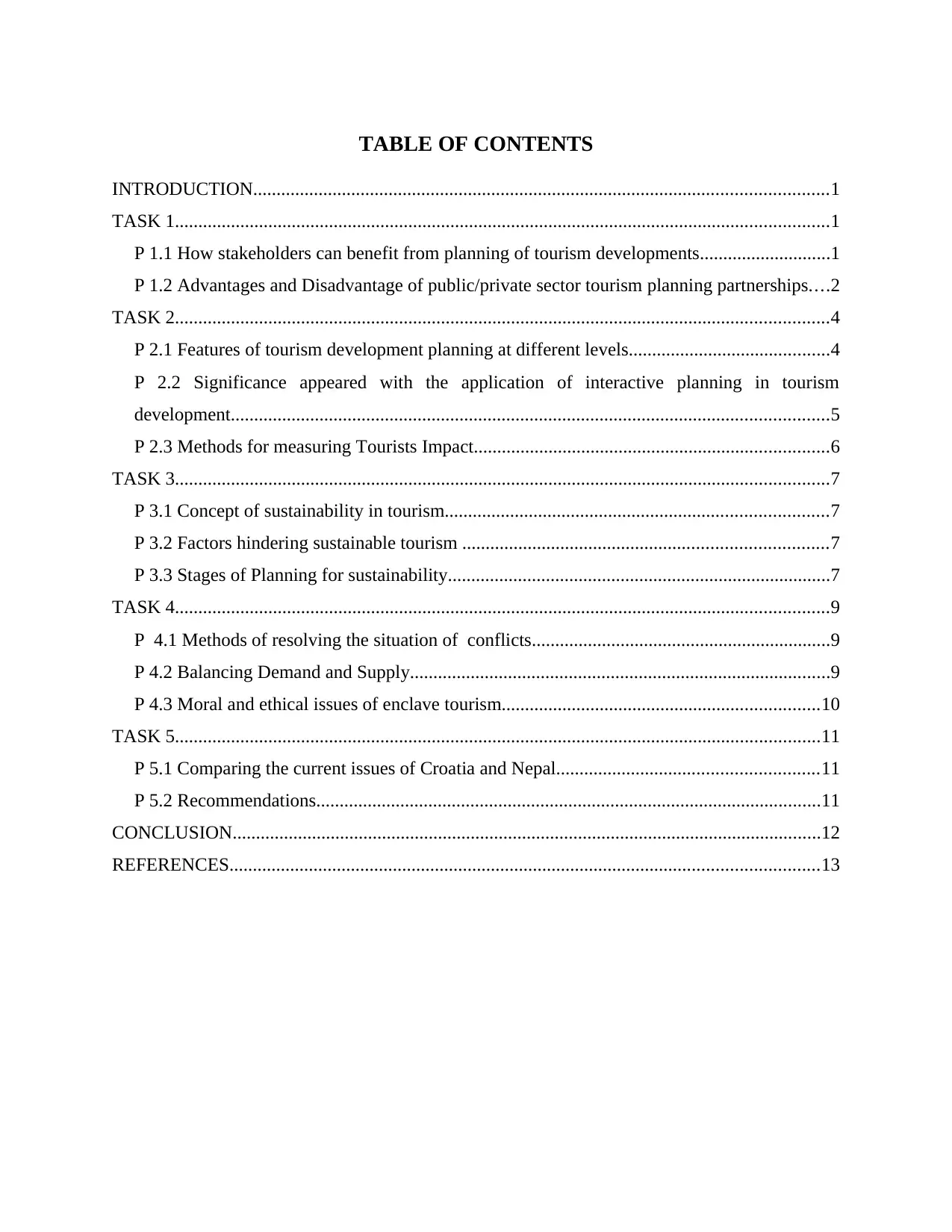
TABLE OF CONTENTS
INTRODUCTION...........................................................................................................................1
TASK 1............................................................................................................................................1
P 1.1 How stakeholders can benefit from planning of tourism developments............................1
P 1.2 Advantages and Disadvantage of public/private sector tourism planning partnerships....2
TASK 2............................................................................................................................................4
P 2.1 Features of tourism development planning at different levels...........................................4
P 2.2 Significance appeared with the application of interactive planning in tourism
development................................................................................................................................5
P 2.3 Methods for measuring Tourists Impact............................................................................6
TASK 3............................................................................................................................................7
P 3.1 Concept of sustainability in tourism..................................................................................7
P 3.2 Factors hindering sustainable tourism ..............................................................................7
P 3.3 Stages of Planning for sustainability..................................................................................7
TASK 4............................................................................................................................................9
P 4.1 Methods of resolving the situation of conflicts................................................................9
P 4.2 Balancing Demand and Supply..........................................................................................9
P 4.3 Moral and ethical issues of enclave tourism....................................................................10
TASK 5..........................................................................................................................................11
P 5.1 Comparing the current issues of Croatia and Nepal........................................................11
P 5.2 Recommendations............................................................................................................11
CONCLUSION..............................................................................................................................12
REFERENCES..............................................................................................................................13
INTRODUCTION...........................................................................................................................1
TASK 1............................................................................................................................................1
P 1.1 How stakeholders can benefit from planning of tourism developments............................1
P 1.2 Advantages and Disadvantage of public/private sector tourism planning partnerships....2
TASK 2............................................................................................................................................4
P 2.1 Features of tourism development planning at different levels...........................................4
P 2.2 Significance appeared with the application of interactive planning in tourism
development................................................................................................................................5
P 2.3 Methods for measuring Tourists Impact............................................................................6
TASK 3............................................................................................................................................7
P 3.1 Concept of sustainability in tourism..................................................................................7
P 3.2 Factors hindering sustainable tourism ..............................................................................7
P 3.3 Stages of Planning for sustainability..................................................................................7
TASK 4............................................................................................................................................9
P 4.1 Methods of resolving the situation of conflicts................................................................9
P 4.2 Balancing Demand and Supply..........................................................................................9
P 4.3 Moral and ethical issues of enclave tourism....................................................................10
TASK 5..........................................................................................................................................11
P 5.1 Comparing the current issues of Croatia and Nepal........................................................11
P 5.2 Recommendations............................................................................................................11
CONCLUSION..............................................................................................................................12
REFERENCES..............................................................................................................................13
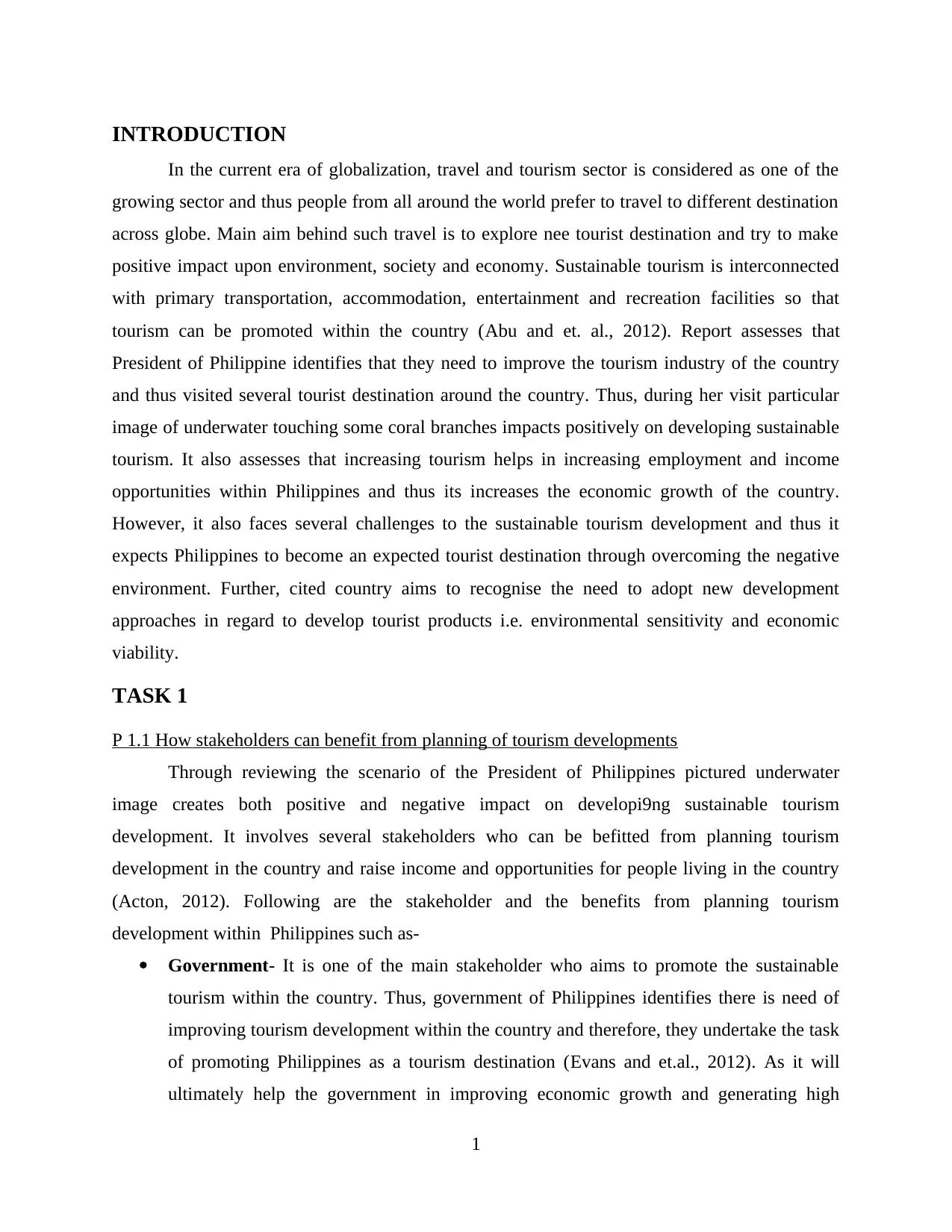
INTRODUCTION
In the current era of globalization, travel and tourism sector is considered as one of the
growing sector and thus people from all around the world prefer to travel to different destination
across globe. Main aim behind such travel is to explore nee tourist destination and try to make
positive impact upon environment, society and economy. Sustainable tourism is interconnected
with primary transportation, accommodation, entertainment and recreation facilities so that
tourism can be promoted within the country (Abu and et. al., 2012). Report assesses that
President of Philippine identifies that they need to improve the tourism industry of the country
and thus visited several tourist destination around the country. Thus, during her visit particular
image of underwater touching some coral branches impacts positively on developing sustainable
tourism. It also assesses that increasing tourism helps in increasing employment and income
opportunities within Philippines and thus its increases the economic growth of the country.
However, it also faces several challenges to the sustainable tourism development and thus it
expects Philippines to become an expected tourist destination through overcoming the negative
environment. Further, cited country aims to recognise the need to adopt new development
approaches in regard to develop tourist products i.e. environmental sensitivity and economic
viability.
TASK 1
P 1.1 How stakeholders can benefit from planning of tourism developments
Through reviewing the scenario of the President of Philippines pictured underwater
image creates both positive and negative impact on developi9ng sustainable tourism
development. It involves several stakeholders who can be befitted from planning tourism
development in the country and raise income and opportunities for people living in the country
(Acton, 2012). Following are the stakeholder and the benefits from planning tourism
development within Philippines such as-
Government- It is one of the main stakeholder who aims to promote the sustainable
tourism within the country. Thus, government of Philippines identifies there is need of
improving tourism development within the country and therefore, they undertake the task
of promoting Philippines as a tourism destination (Evans and et.al., 2012). As it will
ultimately help the government in improving economic growth and generating high
1
In the current era of globalization, travel and tourism sector is considered as one of the
growing sector and thus people from all around the world prefer to travel to different destination
across globe. Main aim behind such travel is to explore nee tourist destination and try to make
positive impact upon environment, society and economy. Sustainable tourism is interconnected
with primary transportation, accommodation, entertainment and recreation facilities so that
tourism can be promoted within the country (Abu and et. al., 2012). Report assesses that
President of Philippine identifies that they need to improve the tourism industry of the country
and thus visited several tourist destination around the country. Thus, during her visit particular
image of underwater touching some coral branches impacts positively on developing sustainable
tourism. It also assesses that increasing tourism helps in increasing employment and income
opportunities within Philippines and thus its increases the economic growth of the country.
However, it also faces several challenges to the sustainable tourism development and thus it
expects Philippines to become an expected tourist destination through overcoming the negative
environment. Further, cited country aims to recognise the need to adopt new development
approaches in regard to develop tourist products i.e. environmental sensitivity and economic
viability.
TASK 1
P 1.1 How stakeholders can benefit from planning of tourism developments
Through reviewing the scenario of the President of Philippines pictured underwater
image creates both positive and negative impact on developi9ng sustainable tourism
development. It involves several stakeholders who can be befitted from planning tourism
development in the country and raise income and opportunities for people living in the country
(Acton, 2012). Following are the stakeholder and the benefits from planning tourism
development within Philippines such as-
Government- It is one of the main stakeholder who aims to promote the sustainable
tourism within the country. Thus, government of Philippines identifies there is need of
improving tourism development within the country and therefore, they undertake the task
of promoting Philippines as a tourism destination (Evans and et.al., 2012). As it will
ultimately help the government in improving economic growth and generating high
1
⊘ This is a preview!⊘
Do you want full access?
Subscribe today to unlock all pages.

Trusted by 1+ million students worldwide
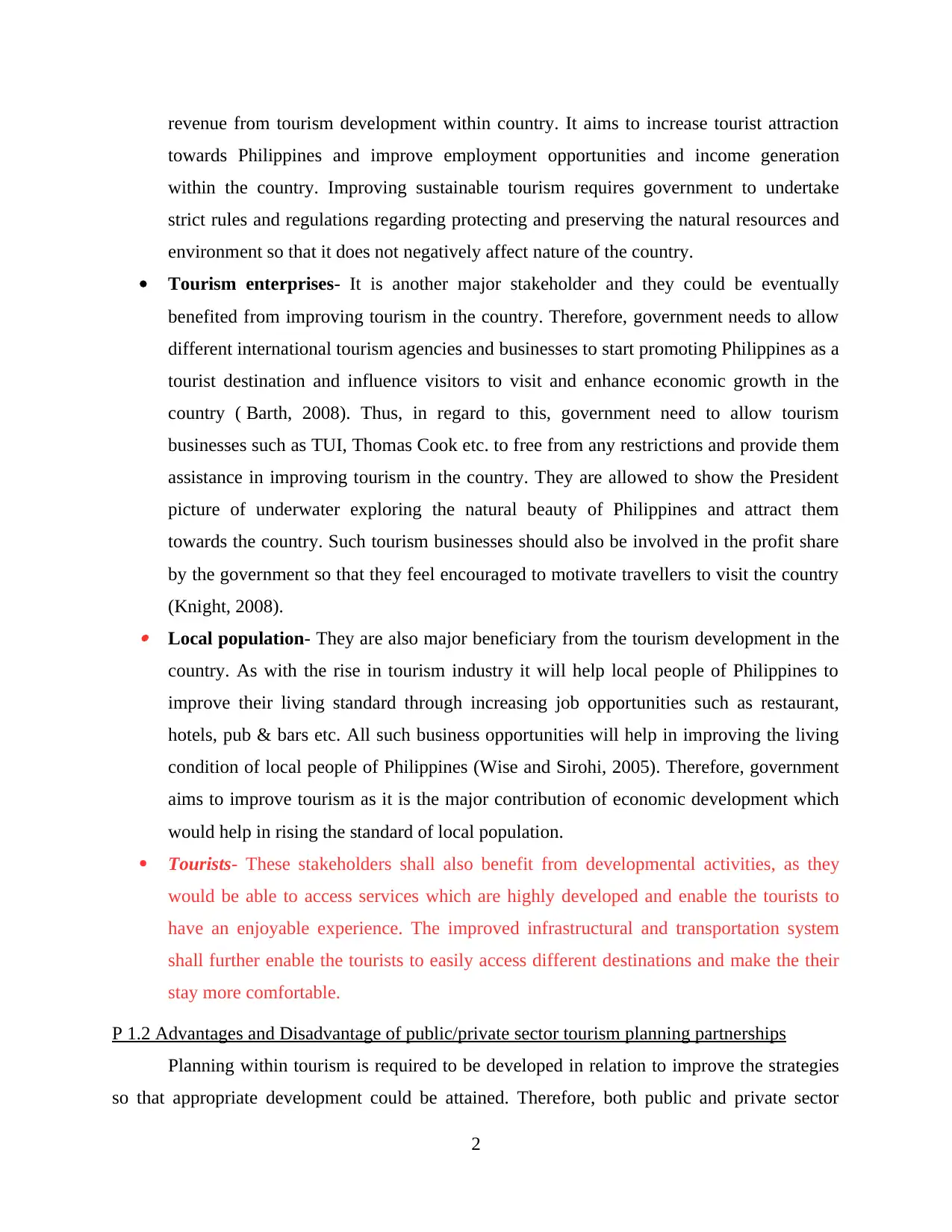
revenue from tourism development within country. It aims to increase tourist attraction
towards Philippines and improve employment opportunities and income generation
within the country. Improving sustainable tourism requires government to undertake
strict rules and regulations regarding protecting and preserving the natural resources and
environment so that it does not negatively affect nature of the country.
Tourism enterprises- It is another major stakeholder and they could be eventually
benefited from improving tourism in the country. Therefore, government needs to allow
different international tourism agencies and businesses to start promoting Philippines as a
tourist destination and influence visitors to visit and enhance economic growth in the
country ( Barth, 2008). Thus, in regard to this, government need to allow tourism
businesses such as TUI, Thomas Cook etc. to free from any restrictions and provide them
assistance in improving tourism in the country. They are allowed to show the President
picture of underwater exploring the natural beauty of Philippines and attract them
towards the country. Such tourism businesses should also be involved in the profit share
by the government so that they feel encouraged to motivate travellers to visit the country
(Knight, 2008). Local population- They are also major beneficiary from the tourism development in the
country. As with the rise in tourism industry it will help local people of Philippines to
improve their living standard through increasing job opportunities such as restaurant,
hotels, pub & bars etc. All such business opportunities will help in improving the living
condition of local people of Philippines (Wise and Sirohi, 2005). Therefore, government
aims to improve tourism as it is the major contribution of economic development which
would help in rising the standard of local population.
Tourists- These stakeholders shall also benefit from developmental activities, as they
would be able to access services which are highly developed and enable the tourists to
have an enjoyable experience. The improved infrastructural and transportation system
shall further enable the tourists to easily access different destinations and make the their
stay more comfortable.
P 1.2 Advantages and Disadvantage of public/private sector tourism planning partnerships
Planning within tourism is required to be developed in relation to improve the strategies
so that appropriate development could be attained. Therefore, both public and private sector
2
towards Philippines and improve employment opportunities and income generation
within the country. Improving sustainable tourism requires government to undertake
strict rules and regulations regarding protecting and preserving the natural resources and
environment so that it does not negatively affect nature of the country.
Tourism enterprises- It is another major stakeholder and they could be eventually
benefited from improving tourism in the country. Therefore, government needs to allow
different international tourism agencies and businesses to start promoting Philippines as a
tourist destination and influence visitors to visit and enhance economic growth in the
country ( Barth, 2008). Thus, in regard to this, government need to allow tourism
businesses such as TUI, Thomas Cook etc. to free from any restrictions and provide them
assistance in improving tourism in the country. They are allowed to show the President
picture of underwater exploring the natural beauty of Philippines and attract them
towards the country. Such tourism businesses should also be involved in the profit share
by the government so that they feel encouraged to motivate travellers to visit the country
(Knight, 2008). Local population- They are also major beneficiary from the tourism development in the
country. As with the rise in tourism industry it will help local people of Philippines to
improve their living standard through increasing job opportunities such as restaurant,
hotels, pub & bars etc. All such business opportunities will help in improving the living
condition of local people of Philippines (Wise and Sirohi, 2005). Therefore, government
aims to improve tourism as it is the major contribution of economic development which
would help in rising the standard of local population.
Tourists- These stakeholders shall also benefit from developmental activities, as they
would be able to access services which are highly developed and enable the tourists to
have an enjoyable experience. The improved infrastructural and transportation system
shall further enable the tourists to easily access different destinations and make the their
stay more comfortable.
P 1.2 Advantages and Disadvantage of public/private sector tourism planning partnerships
Planning within tourism is required to be developed in relation to improve the strategies
so that appropriate development could be attained. Therefore, both public and private sector
2
Paraphrase This Document
Need a fresh take? Get an instant paraphrase of this document with our AI Paraphraser
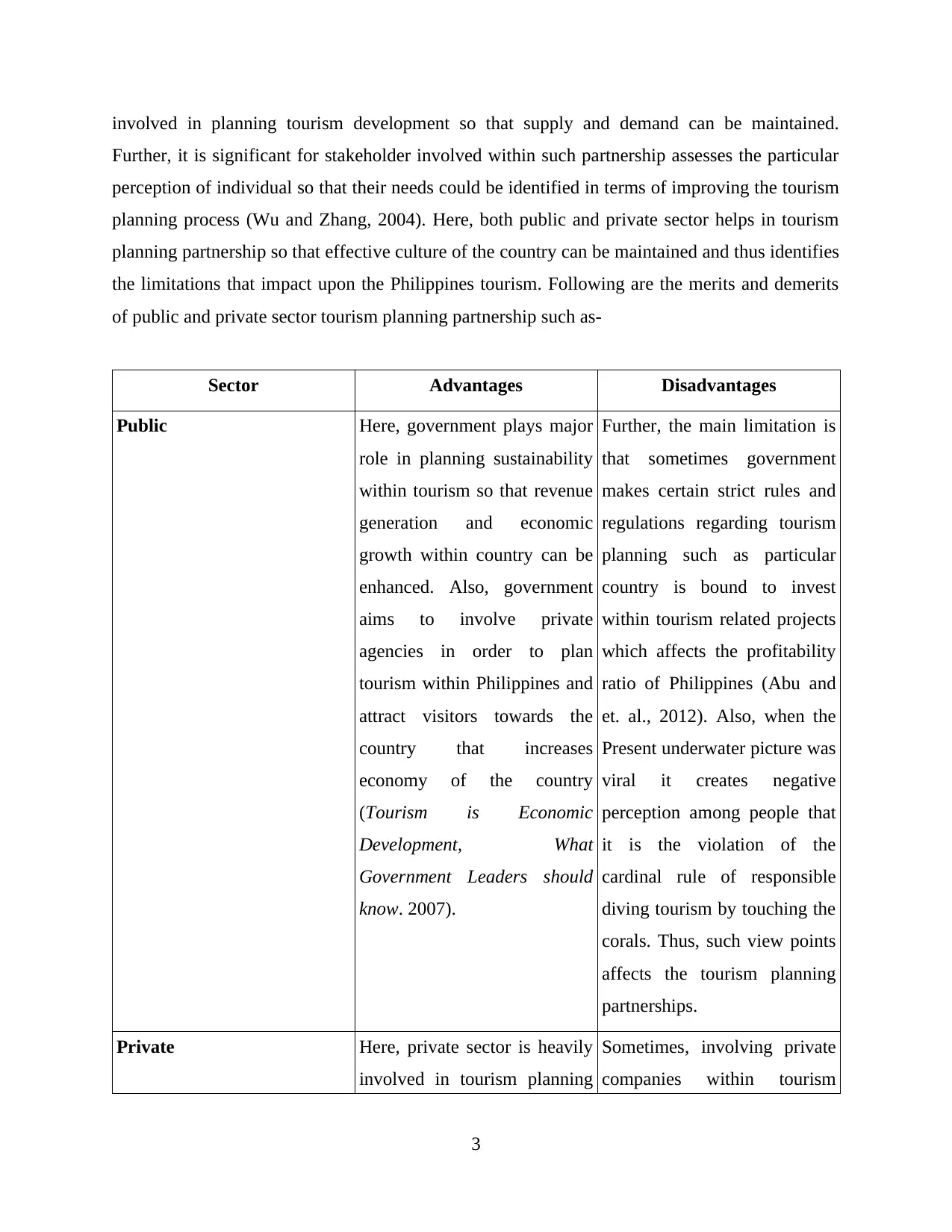
involved in planning tourism development so that supply and demand can be maintained.
Further, it is significant for stakeholder involved within such partnership assesses the particular
perception of individual so that their needs could be identified in terms of improving the tourism
planning process (Wu and Zhang, 2004). Here, both public and private sector helps in tourism
planning partnership so that effective culture of the country can be maintained and thus identifies
the limitations that impact upon the Philippines tourism. Following are the merits and demerits
of public and private sector tourism planning partnership such as-
Sector Advantages Disadvantages
Public Here, government plays major
role in planning sustainability
within tourism so that revenue
generation and economic
growth within country can be
enhanced. Also, government
aims to involve private
agencies in order to plan
tourism within Philippines and
attract visitors towards the
country that increases
economy of the country
(Tourism is Economic
Development, What
Government Leaders should
know. 2007).
Further, the main limitation is
that sometimes government
makes certain strict rules and
regulations regarding tourism
planning such as particular
country is bound to invest
within tourism related projects
which affects the profitability
ratio of Philippines (Abu and
et. al., 2012). Also, when the
Present underwater picture was
viral it creates negative
perception among people that
it is the violation of the
cardinal rule of responsible
diving tourism by touching the
corals. Thus, such view points
affects the tourism planning
partnerships.
Private Here, private sector is heavily
involved in tourism planning
Sometimes, involving private
companies within tourism
3
Further, it is significant for stakeholder involved within such partnership assesses the particular
perception of individual so that their needs could be identified in terms of improving the tourism
planning process (Wu and Zhang, 2004). Here, both public and private sector helps in tourism
planning partnership so that effective culture of the country can be maintained and thus identifies
the limitations that impact upon the Philippines tourism. Following are the merits and demerits
of public and private sector tourism planning partnership such as-
Sector Advantages Disadvantages
Public Here, government plays major
role in planning sustainability
within tourism so that revenue
generation and economic
growth within country can be
enhanced. Also, government
aims to involve private
agencies in order to plan
tourism within Philippines and
attract visitors towards the
country that increases
economy of the country
(Tourism is Economic
Development, What
Government Leaders should
know. 2007).
Further, the main limitation is
that sometimes government
makes certain strict rules and
regulations regarding tourism
planning such as particular
country is bound to invest
within tourism related projects
which affects the profitability
ratio of Philippines (Abu and
et. al., 2012). Also, when the
Present underwater picture was
viral it creates negative
perception among people that
it is the violation of the
cardinal rule of responsible
diving tourism by touching the
corals. Thus, such view points
affects the tourism planning
partnerships.
Private Here, private sector is heavily
involved in tourism planning
Sometimes, involving private
companies within tourism
3
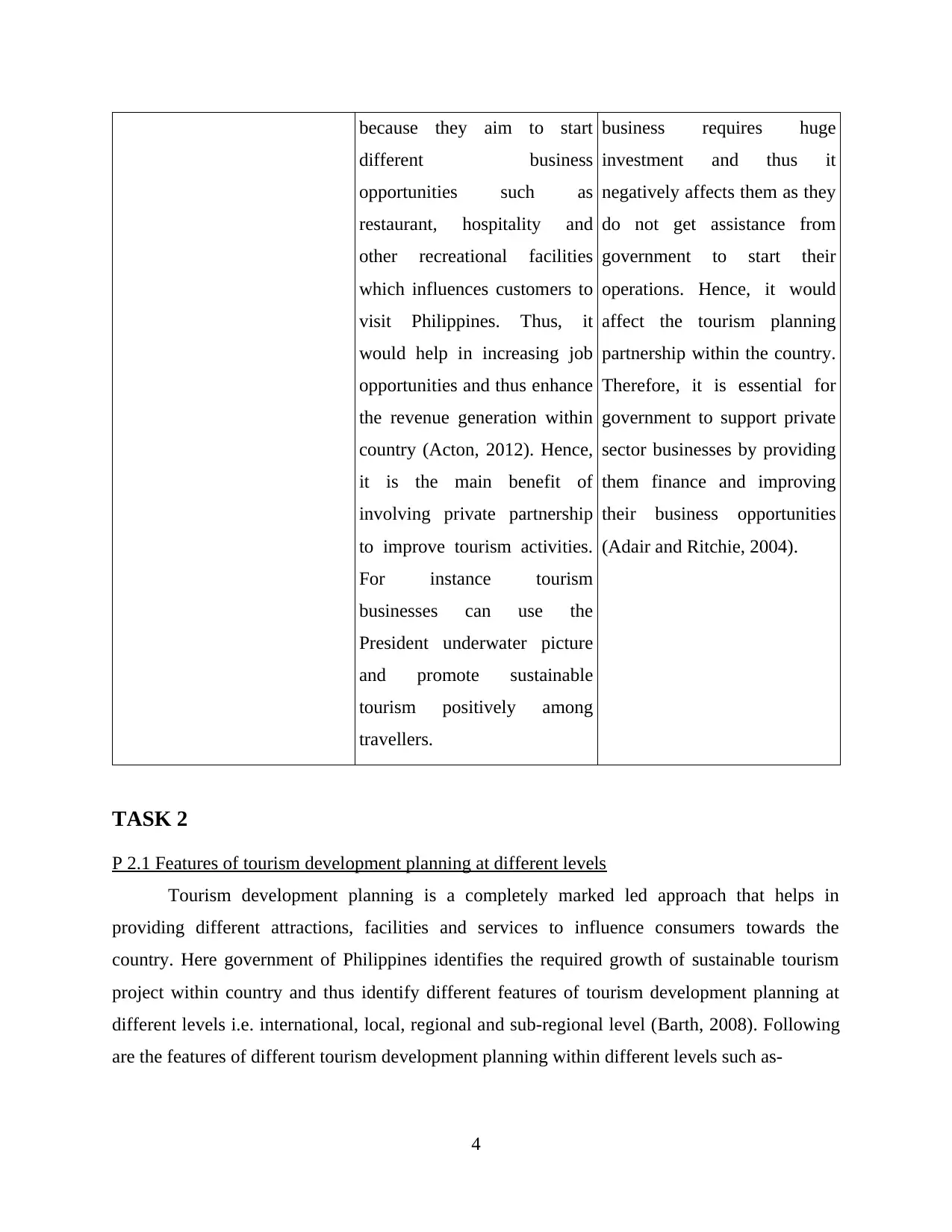
because they aim to start
different business
opportunities such as
restaurant, hospitality and
other recreational facilities
which influences customers to
visit Philippines. Thus, it
would help in increasing job
opportunities and thus enhance
the revenue generation within
country (Acton, 2012). Hence,
it is the main benefit of
involving private partnership
to improve tourism activities.
For instance tourism
businesses can use the
President underwater picture
and promote sustainable
tourism positively among
travellers.
business requires huge
investment and thus it
negatively affects them as they
do not get assistance from
government to start their
operations. Hence, it would
affect the tourism planning
partnership within the country.
Therefore, it is essential for
government to support private
sector businesses by providing
them finance and improving
their business opportunities
(Adair and Ritchie, 2004).
TASK 2
P 2.1 Features of tourism development planning at different levels
Tourism development planning is a completely marked led approach that helps in
providing different attractions, facilities and services to influence consumers towards the
country. Here government of Philippines identifies the required growth of sustainable tourism
project within country and thus identify different features of tourism development planning at
different levels i.e. international, local, regional and sub-regional level (Barth, 2008). Following
are the features of different tourism development planning within different levels such as-
4
different business
opportunities such as
restaurant, hospitality and
other recreational facilities
which influences customers to
visit Philippines. Thus, it
would help in increasing job
opportunities and thus enhance
the revenue generation within
country (Acton, 2012). Hence,
it is the main benefit of
involving private partnership
to improve tourism activities.
For instance tourism
businesses can use the
President underwater picture
and promote sustainable
tourism positively among
travellers.
business requires huge
investment and thus it
negatively affects them as they
do not get assistance from
government to start their
operations. Hence, it would
affect the tourism planning
partnership within the country.
Therefore, it is essential for
government to support private
sector businesses by providing
them finance and improving
their business opportunities
(Adair and Ritchie, 2004).
TASK 2
P 2.1 Features of tourism development planning at different levels
Tourism development planning is a completely marked led approach that helps in
providing different attractions, facilities and services to influence consumers towards the
country. Here government of Philippines identifies the required growth of sustainable tourism
project within country and thus identify different features of tourism development planning at
different levels i.e. international, local, regional and sub-regional level (Barth, 2008). Following
are the features of different tourism development planning within different levels such as-
4
⊘ This is a preview!⊘
Do you want full access?
Subscribe today to unlock all pages.

Trusted by 1+ million students worldwide
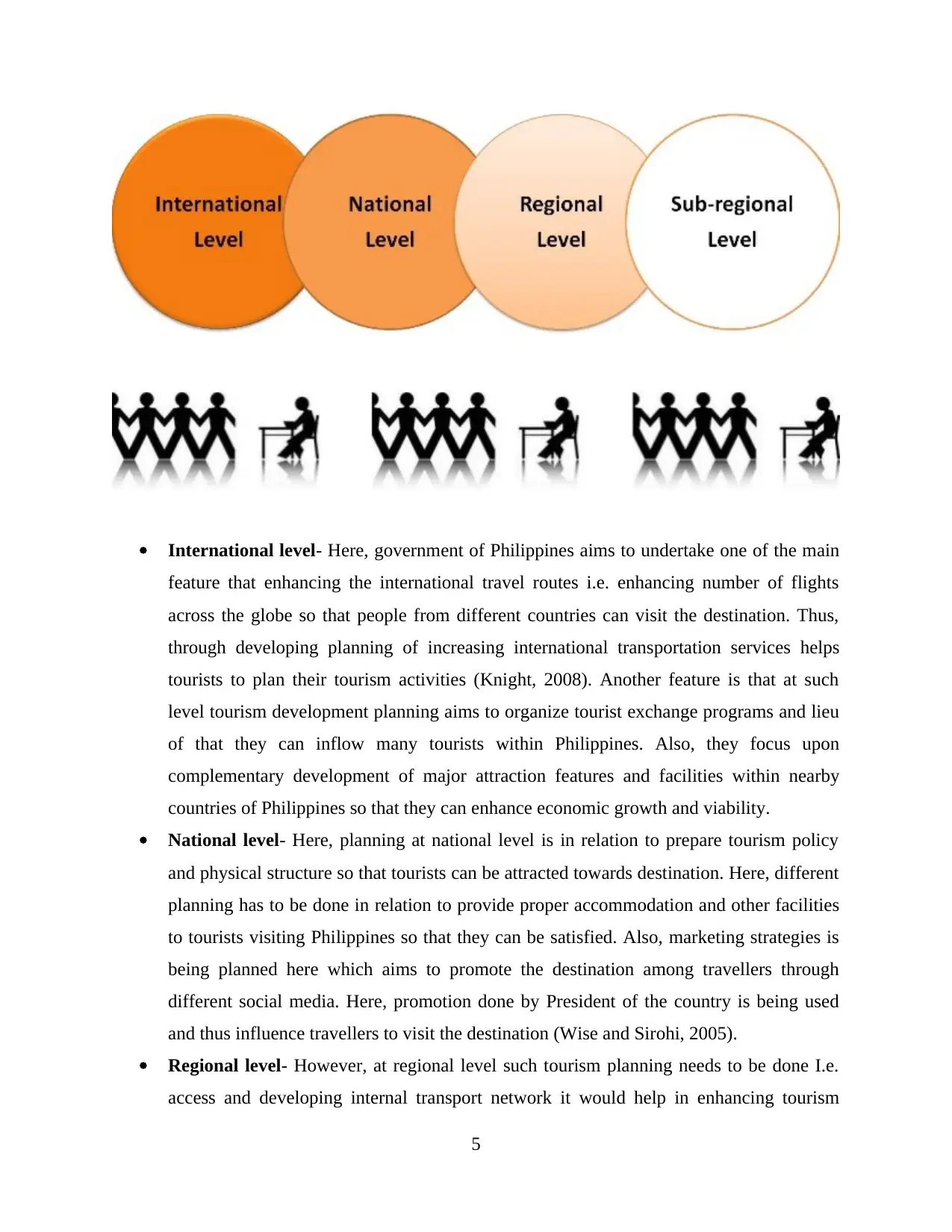
International level- Here, government of Philippines aims to undertake one of the main
feature that enhancing the international travel routes i.e. enhancing number of flights
across the globe so that people from different countries can visit the destination. Thus,
through developing planning of increasing international transportation services helps
tourists to plan their tourism activities (Knight, 2008). Another feature is that at such
level tourism development planning aims to organize tourist exchange programs and lieu
of that they can inflow many tourists within Philippines. Also, they focus upon
complementary development of major attraction features and facilities within nearby
countries of Philippines so that they can enhance economic growth and viability.
National level- Here, planning at national level is in relation to prepare tourism policy
and physical structure so that tourists can be attracted towards destination. Here, different
planning has to be done in relation to provide proper accommodation and other facilities
to tourists visiting Philippines so that they can be satisfied. Also, marketing strategies is
being planned here which aims to promote the destination among travellers through
different social media. Here, promotion done by President of the country is being used
and thus influence travellers to visit the destination (Wise and Sirohi, 2005).
Regional level- However, at regional level such tourism planning needs to be done I.e.
access and developing internal transport network it would help in enhancing tourism
5
feature that enhancing the international travel routes i.e. enhancing number of flights
across the globe so that people from different countries can visit the destination. Thus,
through developing planning of increasing international transportation services helps
tourists to plan their tourism activities (Knight, 2008). Another feature is that at such
level tourism development planning aims to organize tourist exchange programs and lieu
of that they can inflow many tourists within Philippines. Also, they focus upon
complementary development of major attraction features and facilities within nearby
countries of Philippines so that they can enhance economic growth and viability.
National level- Here, planning at national level is in relation to prepare tourism policy
and physical structure so that tourists can be attracted towards destination. Here, different
planning has to be done in relation to provide proper accommodation and other facilities
to tourists visiting Philippines so that they can be satisfied. Also, marketing strategies is
being planned here which aims to promote the destination among travellers through
different social media. Here, promotion done by President of the country is being used
and thus influence travellers to visit the destination (Wise and Sirohi, 2005).
Regional level- However, at regional level such tourism planning needs to be done I.e.
access and developing internal transport network it would help in enhancing tourism
5
Paraphrase This Document
Need a fresh take? Get an instant paraphrase of this document with our AI Paraphraser
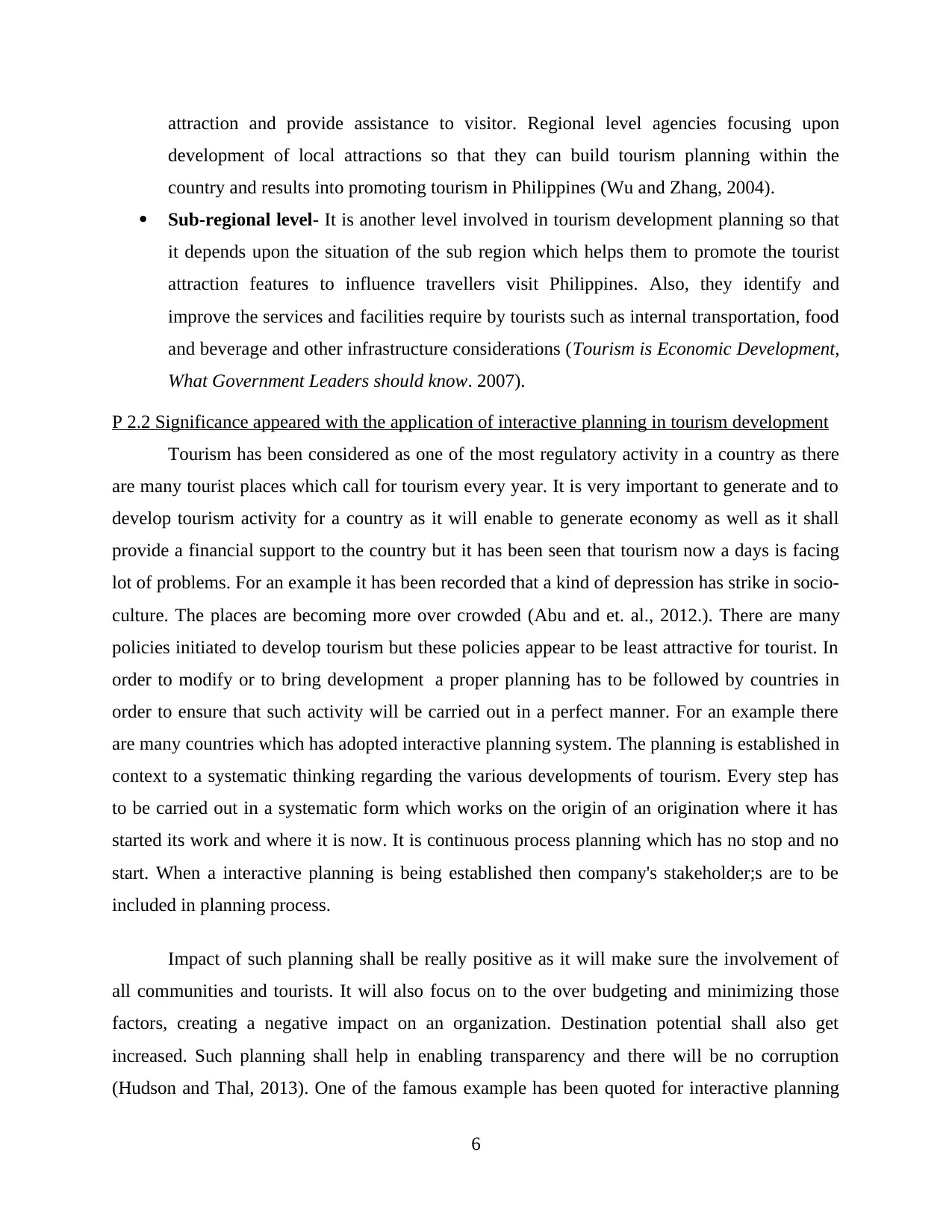
attraction and provide assistance to visitor. Regional level agencies focusing upon
development of local attractions so that they can build tourism planning within the
country and results into promoting tourism in Philippines (Wu and Zhang, 2004).
Sub-regional level- It is another level involved in tourism development planning so that
it depends upon the situation of the sub region which helps them to promote the tourist
attraction features to influence travellers visit Philippines. Also, they identify and
improve the services and facilities require by tourists such as internal transportation, food
and beverage and other infrastructure considerations (Tourism is Economic Development,
What Government Leaders should know. 2007).
P 2.2 Significance appeared with the application of interactive planning in tourism development
Tourism has been considered as one of the most regulatory activity in a country as there
are many tourist places which call for tourism every year. It is very important to generate and to
develop tourism activity for a country as it will enable to generate economy as well as it shall
provide a financial support to the country but it has been seen that tourism now a days is facing
lot of problems. For an example it has been recorded that a kind of depression has strike in socio-
culture. The places are becoming more over crowded (Abu and et. al., 2012.). There are many
policies initiated to develop tourism but these policies appear to be least attractive for tourist. In
order to modify or to bring development a proper planning has to be followed by countries in
order to ensure that such activity will be carried out in a perfect manner. For an example there
are many countries which has adopted interactive planning system. The planning is established in
context to a systematic thinking regarding the various developments of tourism. Every step has
to be carried out in a systematic form which works on the origin of an origination where it has
started its work and where it is now. It is continuous process planning which has no stop and no
start. When a interactive planning is being established then company's stakeholder;s are to be
included in planning process.
Impact of such planning shall be really positive as it will make sure the involvement of
all communities and tourists. It will also focus on to the over budgeting and minimizing those
factors, creating a negative impact on an organization. Destination potential shall also get
increased. Such planning shall help in enabling transparency and there will be no corruption
(Hudson and Thal, 2013). One of the famous example has been quoted for interactive planning
6
development of local attractions so that they can build tourism planning within the
country and results into promoting tourism in Philippines (Wu and Zhang, 2004).
Sub-regional level- It is another level involved in tourism development planning so that
it depends upon the situation of the sub region which helps them to promote the tourist
attraction features to influence travellers visit Philippines. Also, they identify and
improve the services and facilities require by tourists such as internal transportation, food
and beverage and other infrastructure considerations (Tourism is Economic Development,
What Government Leaders should know. 2007).
P 2.2 Significance appeared with the application of interactive planning in tourism development
Tourism has been considered as one of the most regulatory activity in a country as there
are many tourist places which call for tourism every year. It is very important to generate and to
develop tourism activity for a country as it will enable to generate economy as well as it shall
provide a financial support to the country but it has been seen that tourism now a days is facing
lot of problems. For an example it has been recorded that a kind of depression has strike in socio-
culture. The places are becoming more over crowded (Abu and et. al., 2012.). There are many
policies initiated to develop tourism but these policies appear to be least attractive for tourist. In
order to modify or to bring development a proper planning has to be followed by countries in
order to ensure that such activity will be carried out in a perfect manner. For an example there
are many countries which has adopted interactive planning system. The planning is established in
context to a systematic thinking regarding the various developments of tourism. Every step has
to be carried out in a systematic form which works on the origin of an origination where it has
started its work and where it is now. It is continuous process planning which has no stop and no
start. When a interactive planning is being established then company's stakeholder;s are to be
included in planning process.
Impact of such planning shall be really positive as it will make sure the involvement of
all communities and tourists. It will also focus on to the over budgeting and minimizing those
factors, creating a negative impact on an organization. Destination potential shall also get
increased. Such planning shall help in enabling transparency and there will be no corruption
(Hudson and Thal, 2013). One of the famous example has been quoted for interactive planning
6
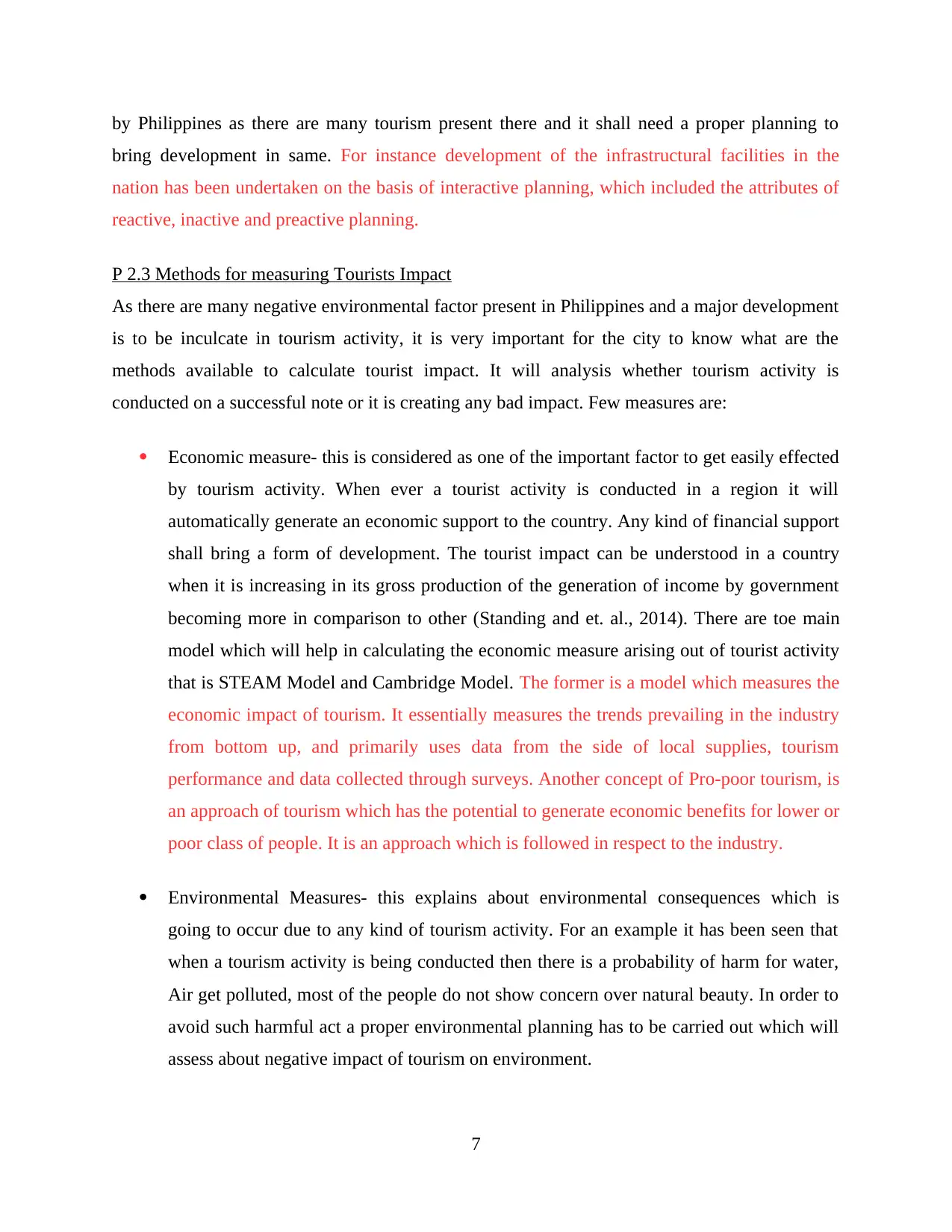
by Philippines as there are many tourism present there and it shall need a proper planning to
bring development in same. For instance development of the infrastructural facilities in the
nation has been undertaken on the basis of interactive planning, which included the attributes of
reactive, inactive and preactive planning.
P 2.3 Methods for measuring Tourists Impact
As there are many negative environmental factor present in Philippines and a major development
is to be inculcate in tourism activity, it is very important for the city to know what are the
methods available to calculate tourist impact. It will analysis whether tourism activity is
conducted on a successful note or it is creating any bad impact. Few measures are:
Economic measure- this is considered as one of the important factor to get easily effected
by tourism activity. When ever a tourist activity is conducted in a region it will
automatically generate an economic support to the country. Any kind of financial support
shall bring a form of development. The tourist impact can be understood in a country
when it is increasing in its gross production of the generation of income by government
becoming more in comparison to other (Standing and et. al., 2014). There are toe main
model which will help in calculating the economic measure arising out of tourist activity
that is STEAM Model and Cambridge Model. The former is a model which measures the
economic impact of tourism. It essentially measures the trends prevailing in the industry
from bottom up, and primarily uses data from the side of local supplies, tourism
performance and data collected through surveys. Another concept of Pro-poor tourism, is
an approach of tourism which has the potential to generate economic benefits for lower or
poor class of people. It is an approach which is followed in respect to the industry.
Environmental Measures- this explains about environmental consequences which is
going to occur due to any kind of tourism activity. For an example it has been seen that
when a tourism activity is being conducted then there is a probability of harm for water,
Air get polluted, most of the people do not show concern over natural beauty. In order to
avoid such harmful act a proper environmental planning has to be carried out which will
assess about negative impact of tourism on environment.
7
bring development in same. For instance development of the infrastructural facilities in the
nation has been undertaken on the basis of interactive planning, which included the attributes of
reactive, inactive and preactive planning.
P 2.3 Methods for measuring Tourists Impact
As there are many negative environmental factor present in Philippines and a major development
is to be inculcate in tourism activity, it is very important for the city to know what are the
methods available to calculate tourist impact. It will analysis whether tourism activity is
conducted on a successful note or it is creating any bad impact. Few measures are:
Economic measure- this is considered as one of the important factor to get easily effected
by tourism activity. When ever a tourist activity is conducted in a region it will
automatically generate an economic support to the country. Any kind of financial support
shall bring a form of development. The tourist impact can be understood in a country
when it is increasing in its gross production of the generation of income by government
becoming more in comparison to other (Standing and et. al., 2014). There are toe main
model which will help in calculating the economic measure arising out of tourist activity
that is STEAM Model and Cambridge Model. The former is a model which measures the
economic impact of tourism. It essentially measures the trends prevailing in the industry
from bottom up, and primarily uses data from the side of local supplies, tourism
performance and data collected through surveys. Another concept of Pro-poor tourism, is
an approach of tourism which has the potential to generate economic benefits for lower or
poor class of people. It is an approach which is followed in respect to the industry.
Environmental Measures- this explains about environmental consequences which is
going to occur due to any kind of tourism activity. For an example it has been seen that
when a tourism activity is being conducted then there is a probability of harm for water,
Air get polluted, most of the people do not show concern over natural beauty. In order to
avoid such harmful act a proper environmental planning has to be carried out which will
assess about negative impact of tourism on environment.
7
⊘ This is a preview!⊘
Do you want full access?
Subscribe today to unlock all pages.

Trusted by 1+ million students worldwide
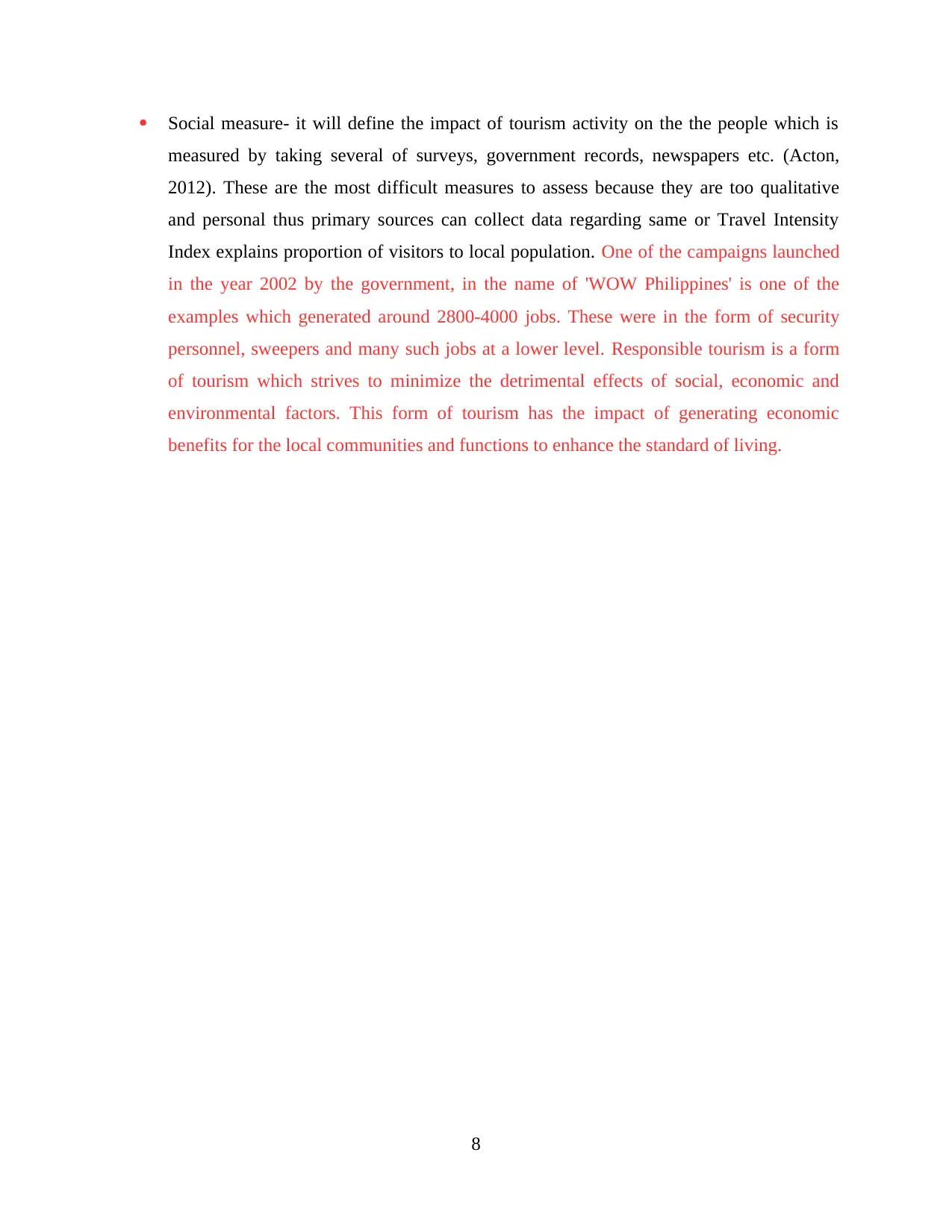
Social measure- it will define the impact of tourism activity on the the people which is
measured by taking several of surveys, government records, newspapers etc. (Acton,
2012). These are the most difficult measures to assess because they are too qualitative
and personal thus primary sources can collect data regarding same or Travel Intensity
Index explains proportion of visitors to local population. One of the campaigns launched
in the year 2002 by the government, in the name of 'WOW Philippines' is one of the
examples which generated around 2800-4000 jobs. These were in the form of security
personnel, sweepers and many such jobs at a lower level. Responsible tourism is a form
of tourism which strives to minimize the detrimental effects of social, economic and
environmental factors. This form of tourism has the impact of generating economic
benefits for the local communities and functions to enhance the standard of living.
8
measured by taking several of surveys, government records, newspapers etc. (Acton,
2012). These are the most difficult measures to assess because they are too qualitative
and personal thus primary sources can collect data regarding same or Travel Intensity
Index explains proportion of visitors to local population. One of the campaigns launched
in the year 2002 by the government, in the name of 'WOW Philippines' is one of the
examples which generated around 2800-4000 jobs. These were in the form of security
personnel, sweepers and many such jobs at a lower level. Responsible tourism is a form
of tourism which strives to minimize the detrimental effects of social, economic and
environmental factors. This form of tourism has the impact of generating economic
benefits for the local communities and functions to enhance the standard of living.
8
Paraphrase This Document
Need a fresh take? Get an instant paraphrase of this document with our AI Paraphraser
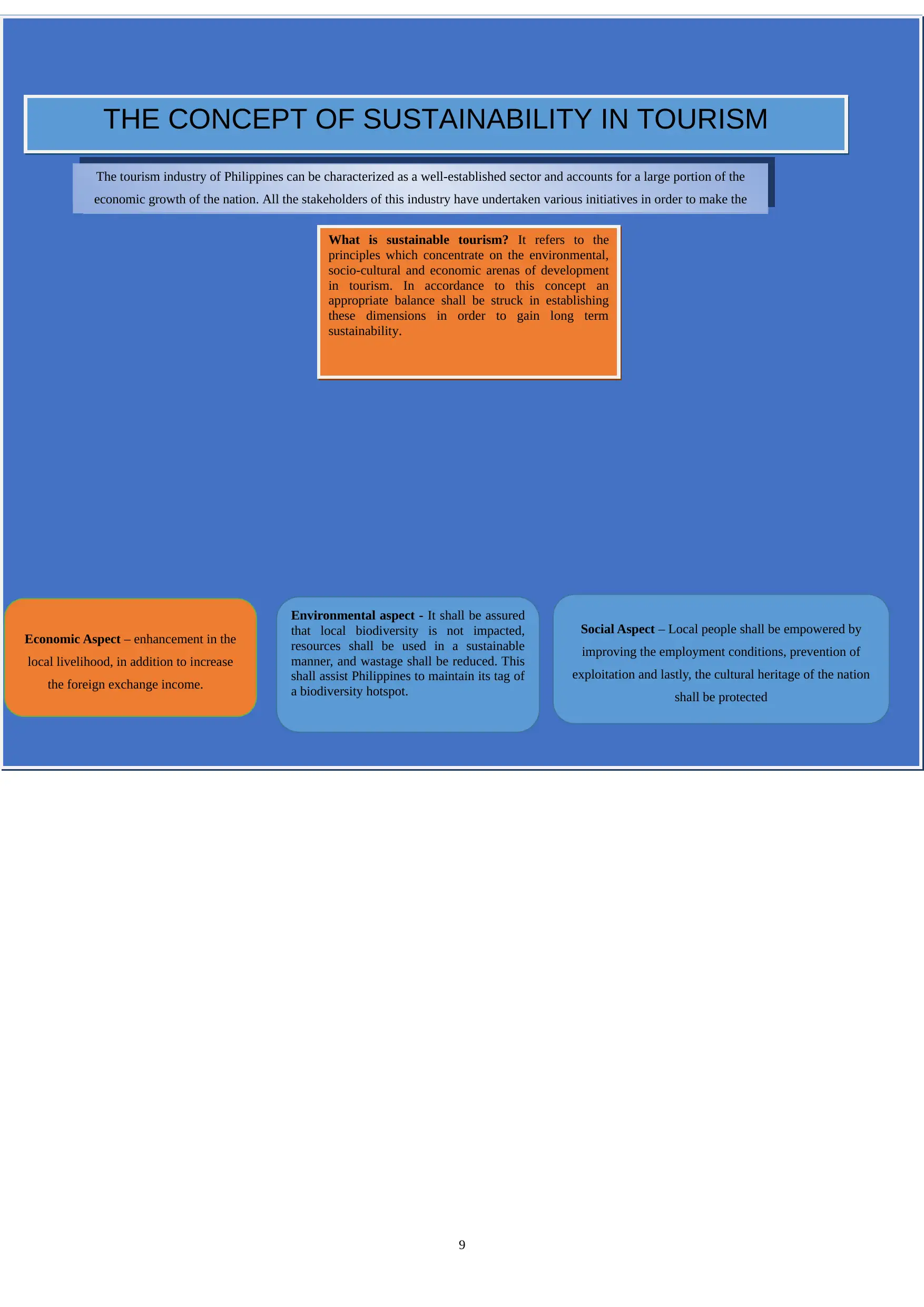
TASK 3
P 3.1 Concept of sustainability in tourism
In the early age, cultural aspects, learning languages and travelling challenges restricted (Capacci, Scorcu and Vici, 2015). In 14 century
Christopher Columbus sailed westward and vasco da gama cruised to country for earn money then business travel has been integral part of
tourism industry(Cave and Brown 2012).
Early tourism started with Nomads who travelled around the world in search of food and
shelter. Main intension of this traveller is to gathered food and traded around the world and gave rise to the barter system (Capacci, Scorcu and
Vici, 2015). 1500 BC is marked as the era when the Europeans visited pyramids and thus developed the tourism for pilgrimage. Early tourism
started with Nomads who travelled around the world in search of food and shelter. Main intension of this traveller is to gathered food and traded
around the world and gave rise to the barter system (Capacci, Scorcu and Vici, 2015). 1500 BC is marked as the era when the Europeans visited
pyramids and thus developed the tourism for pilgrimage.
9
THE CONCEPT OF SUSTAINABILITY IN TOURISM
DEVELOPMENTThe tourism industry of Philippines can be characterized as a well-established sector and accounts for a large portion of the
economic growth of the nation. All the stakeholders of this industry have undertaken various initiatives in order to make the
sector completely sustainable in nature.
What is sustainable tourism? It refers to the
principles which concentrate on the environmental,
socio-cultural and economic arenas of development
in tourism. In accordance to this concept an
appropriate balance shall be struck in establishing
these dimensions in order to gain long term
sustainability.
Social Aspect – Local people shall be empowered by
improving the employment conditions, prevention of
exploitation and lastly, the cultural heritage of the nation
shall be protected
Economic Aspect – enhancement in the
local livelihood, in addition to increase
the foreign exchange income.
Environmental aspect - It shall be assured
that local biodiversity is not impacted,
resources shall be used in a sustainable
manner, and wastage shall be reduced. This
shall assist Philippines to maintain its tag of
a biodiversity hotspot.
P 3.1 Concept of sustainability in tourism
In the early age, cultural aspects, learning languages and travelling challenges restricted (Capacci, Scorcu and Vici, 2015). In 14 century
Christopher Columbus sailed westward and vasco da gama cruised to country for earn money then business travel has been integral part of
tourism industry(Cave and Brown 2012).
Early tourism started with Nomads who travelled around the world in search of food and
shelter. Main intension of this traveller is to gathered food and traded around the world and gave rise to the barter system (Capacci, Scorcu and
Vici, 2015). 1500 BC is marked as the era when the Europeans visited pyramids and thus developed the tourism for pilgrimage. Early tourism
started with Nomads who travelled around the world in search of food and shelter. Main intension of this traveller is to gathered food and traded
around the world and gave rise to the barter system (Capacci, Scorcu and Vici, 2015). 1500 BC is marked as the era when the Europeans visited
pyramids and thus developed the tourism for pilgrimage.
9
THE CONCEPT OF SUSTAINABILITY IN TOURISM
DEVELOPMENTThe tourism industry of Philippines can be characterized as a well-established sector and accounts for a large portion of the
economic growth of the nation. All the stakeholders of this industry have undertaken various initiatives in order to make the
sector completely sustainable in nature.
What is sustainable tourism? It refers to the
principles which concentrate on the environmental,
socio-cultural and economic arenas of development
in tourism. In accordance to this concept an
appropriate balance shall be struck in establishing
these dimensions in order to gain long term
sustainability.
Social Aspect – Local people shall be empowered by
improving the employment conditions, prevention of
exploitation and lastly, the cultural heritage of the nation
shall be protected
Economic Aspect – enhancement in the
local livelihood, in addition to increase
the foreign exchange income.
Environmental aspect - It shall be assured
that local biodiversity is not impacted,
resources shall be used in a sustainable
manner, and wastage shall be reduced. This
shall assist Philippines to maintain its tag of
a biodiversity hotspot.
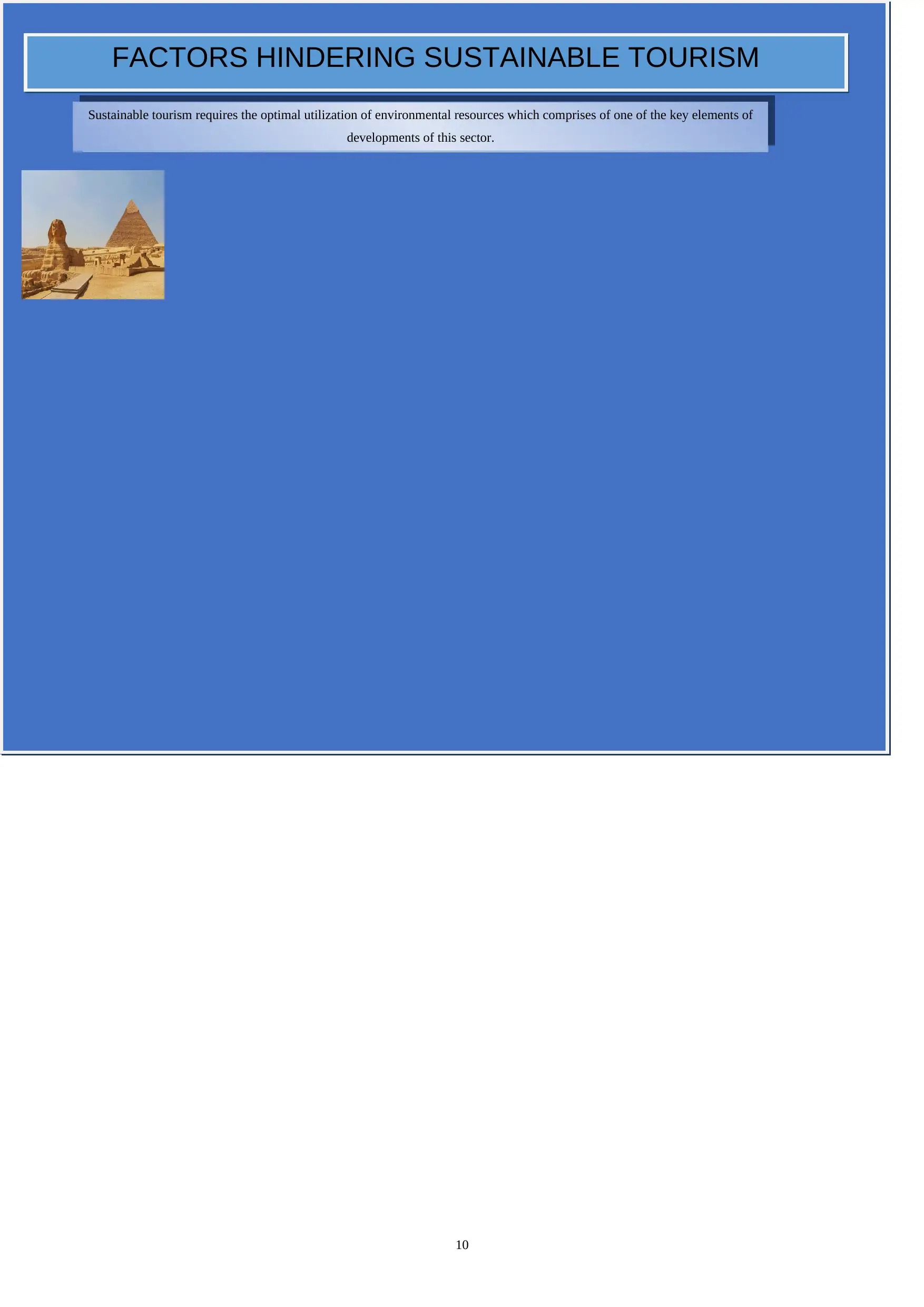
P 3.2 Factors hindering sustainable tourism
In the early age, cultural aspects, learning languages and travelling challenges restricted (Capacci, Scorcu and Vici, 2015). In 14 century
Christopher Columbus sailed westward and vasco da gama cruised to country for earn money then business travel has been integral part of
tourism industry(Cave and Brown
2012).
Early tourism started with Nomads who travelled around the world in search of food
and shelter. Main intension of this traveller is to gathered food and traded around the world and gave rise to the barter system (Capacci,
Scorcu and Vici, 2015). 1500 BC is marked as the era when the Europeans visited pyramids and thus developed the tourism for pilgrimage.
Early tourism started with Nomads who travelled around the world in search of food and shelter. Main intension of this traveller is to
gathered food and traded around the world and gave rise to the barter system (Capacci, Scorcu and Vici, 2015). 1500 BC is marked as the
era when the Europeans visited pyramids and thus developed the tourism for pilgrimage.
10
The authenticity of the socio-cultural aspect of the local communities
shall be respected and also a contribution shall be made to the inter-
cultural understanding.
An informed participation of all the stakeholders shall be assured, in
addition, equal distribution of the benefits shall also be made.
Some of the factors which prevent sustainable development of tourism are:
Lack of support from the stakeholders or lack in individual involvement,
lack of coordination between the bureaucracy,
lack of awareness at the end of all the involved stakeholders,
huge amount of marine waste dumped by the ships.
Sustainable tourism requires the optimal utilization of environmental resources which comprises of one of the key elements of
developments of this sector.
FACTORS HINDERING SUSTAINABLE TOURISM
DEVELOPMENT
In the early age, cultural aspects, learning languages and travelling challenges restricted (Capacci, Scorcu and Vici, 2015). In 14 century
Christopher Columbus sailed westward and vasco da gama cruised to country for earn money then business travel has been integral part of
tourism industry(Cave and Brown
2012).
Early tourism started with Nomads who travelled around the world in search of food
and shelter. Main intension of this traveller is to gathered food and traded around the world and gave rise to the barter system (Capacci,
Scorcu and Vici, 2015). 1500 BC is marked as the era when the Europeans visited pyramids and thus developed the tourism for pilgrimage.
Early tourism started with Nomads who travelled around the world in search of food and shelter. Main intension of this traveller is to
gathered food and traded around the world and gave rise to the barter system (Capacci, Scorcu and Vici, 2015). 1500 BC is marked as the
era when the Europeans visited pyramids and thus developed the tourism for pilgrimage.
10
The authenticity of the socio-cultural aspect of the local communities
shall be respected and also a contribution shall be made to the inter-
cultural understanding.
An informed participation of all the stakeholders shall be assured, in
addition, equal distribution of the benefits shall also be made.
Some of the factors which prevent sustainable development of tourism are:
Lack of support from the stakeholders or lack in individual involvement,
lack of coordination between the bureaucracy,
lack of awareness at the end of all the involved stakeholders,
huge amount of marine waste dumped by the ships.
Sustainable tourism requires the optimal utilization of environmental resources which comprises of one of the key elements of
developments of this sector.
FACTORS HINDERING SUSTAINABLE TOURISM
DEVELOPMENT
⊘ This is a preview!⊘
Do you want full access?
Subscribe today to unlock all pages.

Trusted by 1+ million students worldwide
1 out of 19
Related Documents
Your All-in-One AI-Powered Toolkit for Academic Success.
+13062052269
info@desklib.com
Available 24*7 on WhatsApp / Email
![[object Object]](/_next/static/media/star-bottom.7253800d.svg)
Unlock your academic potential
Copyright © 2020–2025 A2Z Services. All Rights Reserved. Developed and managed by ZUCOL.





